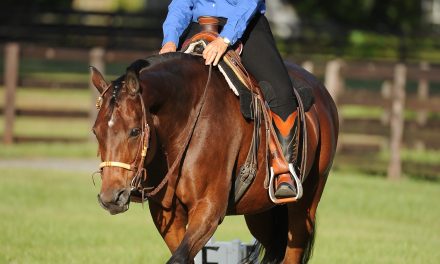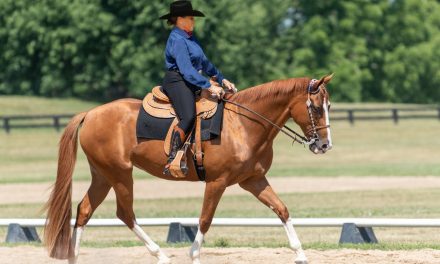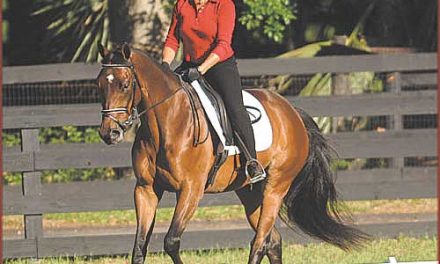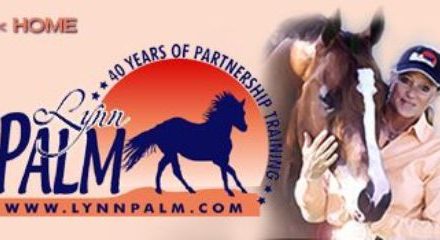Palm Partnership Training™
Building a Partnership with Your Horse
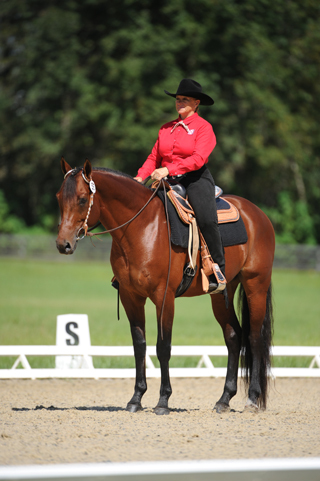 The rider’s aids are her tools to communicate with her horse. The “natural” aids, which she uses to respond to her horse, are her seat, legs, and hands. The rider’s seat, and especially her legs, controls two-thirds of the horse’s body from the wither back. Her hands control the forward one-third of the horse’s body including the shoulders, neck, and head. Let’s look at each of these important aids.
The rider’s aids are her tools to communicate with her horse. The “natural” aids, which she uses to respond to her horse, are her seat, legs, and hands. The rider’s seat, and especially her legs, controls two-thirds of the horse’s body from the wither back. Her hands control the forward one-third of the horse’s body including the shoulders, neck, and head. Let’s look at each of these important aids.
The Seat: The rider’s seat works as an aid to help the horse go forward or slow down. The seat works by applying weight into the saddle on the horse’s back according to what response the rider wants. She uses more weight in her seat for more response, less weight for a lighter response. The weight that the rider applies through her seat, on the saddle has two functions. It indicates to the horse her desire to go forward or slow down and helps him to accomplish these actions. I’ll explain more about the function of the seat in upcoming editions of this newsletter series.
The Legs: The legs work as an aid because the horse moves away from pressure. In moving away from the rider’s leg pressure, a horse can go forward, sideways, or back. The legs as an aid are used slightly behind the girth. This is the proper position for the rider’s leg. When the rider applies her legs to communicate with her horse, it should always be first done with the lightest amount of pressure with a light squeeze slightly behind the girth.
What should the rider do if her horse does not respond to her leg aids? Here are some tips for “tuning up” leg aid communication.
The Hands: The rider’s hands control the reins. To give rein aids properly the hands must be in the correct position at all times which is in front of the saddle. The rider uses the reins for two purposes: speed control and turning.
The rider’s hands on the reins can be used to slow the horse down as well as responding with the hands as he moves forward at the rider’s command. Speed control can be done through the action of the rider’s fingers. With her hands holding the reins, the rider closes her fingers around the reins to ask her horse to slow. When she wants her horse to go forward, she opens her fingers slightly while still holding onto the reins to allow her horse the freedom to move forward.
The second use of the hands on the reins is to turn the horse. I like to use what is called an “open rein” to direct the horse to turn. With hands evenly holding the reins in front of the saddle, to turn my horse to the left I will move my left hand and left rein sideways slightly away from the horse’s neck. I do this through the action of my elbow, not my wrist and NEVER BY PULLING BACK on the rein. Pulling back restricts that horse’s forward motion. We do not want to this because a turn is not possible without forward motion!
When turning, the inside rein (“inside” meaning the rein on the side toward where you will be turning) is the POSITIONING REIN. Its job is to position or direct the horse in the direction you want to travel. The outside rein is the TURNING REIN. The outside rein is held against the horse’s neck without the rider’s hand crossing over the horse’s neck The horse moves away from the action or pressure of the outside rein lying against his neck and turns. Going back to my example if I were turning left, I would lay the right rein against the horse’s neck asking him to move away from the rein pressure and turn to the left while I would use my left rein to lightly position him for the turn.
If more turning action is needed, the rider should slightly raise the outside hand to move the turning rein further up the neck. If less turning action is desired or a lighter response is sought, she should keep the outside rein closer to the base of the horse’s shoulder.
Next article we will put these aids together to learn more about their affect on communicating with our horse and how to improve our conversations!
Your Next Step…
One issue many riders have is their horses do not respond to their leg aids. Here is a progression of steps the rider can use to “turn up the volume” with her leg aids and communicate without shouting!
If the rider does not get a reaction when a leg aid is lightly applied behind the girth, the first step is for her to move her leg slightly further back on his barrel and reapply the leg aid. To do this properly, the rider should move her leg back from the hip and only slightly bend her knee to bring her lower leg further back. Her heel stays down. The rider applying a leg aid further back from the girth always will give more indication to the horse to move his body. In taking this next step, avoid the common error of bending the knee to lift the lower leg higher on the horse’s barrel. This brings the heel up high on the horse’s side. This is not an effective leg aid.
If the horse still doesn’t respond, keeping her heel down the rider should use a “vibrating” leg pressure. Keeping her heel down, she should apply a rapid on-and-off pressure with the side of her lower leg behind the girth. A vibrating leg pressure is not the same as poking the horse with the heels! Poking and kicking will only irritate the horse and eventually make him duller to the leg aids. A vibrating pressure should liven up him up without a lot of excess squeezing.
The horse still doesn’t respond? Use an abrupt, quick action with the leg behind the girth. Again it is done with the lower leg flat against his barrel (not delivered with the heel) giving a quick, more assertive bump behind the girth to get a reaction from the horse. When he responds go back to giving him the lightest of aids by asking him with a light squeeze with the leg.
Remember a golden rule of aids communication… no matter what level of communication you must use to get a response from your horse, always come back to the lightest aid possible.
The aids are our way of communicating with our horses. Remember the old commercial that had the tag line; “when you want someone to listen, whisper”? We want to speak softly and lightly to our equine partners to keep their attention. Only when we don’t get a response, might it be necessary to use more volume to get their attention. Once we do, we go back to soft, light communication to make sure they don’t tune us out. Make it your goal to use your aids to whisper, not shout, to your equine partner!
Until then, follow your dreams…

